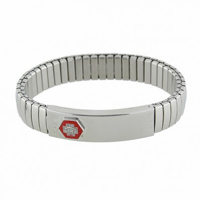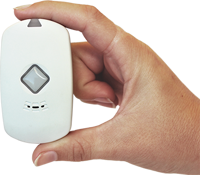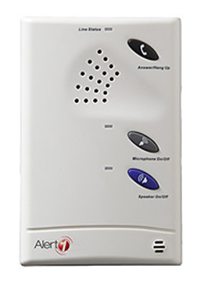Glossary—Alert1 Medical Alert Service

Medical alarm terminology can be difficult to follow. Here, we provide a list of commonly used words you may find useful when searching for medical alert devices.
A1AP
Alert1 Advantage Plan is a warranty plan in case of damage to your medical alert system.
AARP
Senior focused interest group that offers discounts. Alert1 offers a $1/month AARP discount.
Aging in place
Aging in place describes a person living in the residence of their choice, for as long as they are able.
Back-Up Battery
Alert1 medical alert systems come with an integrated battery system that automatically insures that the medical alert base station will continue to operate normally for up to 24 hours during a power failure.
Back-Up Power Supply
An integrated battery system that automatically insures the medical alert base station will continue to operate normally for up to 24 hours during a power failure.
Base Unit
Alert1’s home medical alert systems use a base station that plugs into the wall and provides a coverage range of 600 ft. During an emergency, the Alert1 Command Center will speak through the base unit’s two-way speaker and microphone.

Battery Testing
The medical alert base station monitors the power level of the battery and the emergency help button. The device automatically notifies Alert1 when the battery needs to be replaced. When we receive the notification that the emergency help button battery is low, we send a replacement emergency button at no additional cost.
BBB
Better Business Bureau. Alert1 is BBB accredited and has an A rating.
Bill Payer
Individual who is paying for someone to use Alert1's medical alert monitoring system.
CAPS
Certified Aging in Place Specialist.
CARE
Compassion Answer Respect Evaluate. An acronym to help guide indivdiuals when talking to senior loved ones about getting a medical alert.
Caregiver
A family member or paid helper who regularly looks after a child or a sick, elderly, or disabled person.
Circle of Care
The group of people we setup to contact when you press the emergency help button on your medical alert system.
Command Center
Where help button calls are directed. The operator assesses the situation and contacts emergency services or a loved one. Command Center operators are available 24 hours a day, 365 days a year.
Synonyms: Emergency Monitoring Center, Monitoring Center, Central Station.
Coverage Area
The area where the medical alert system works. Alert1 coverage area is nationwide.
TMA 5 Diamond Certified
The Monitoring Association. Alert1’s Command Center operators go through a rigorous emergency care training program to become TMA 5 Diamond Certified.
DSL
Digital Subscriber Line method of connecting to the internet. Our home based systems do work with DSL, although you may need an adapter.
A waterproof emergency button, usually worn as a pendant or wristband. Pressing the button places a call to our emergency response center.
Synonyms: duress button, elderly help button, emergency call button, medical alert button, medical panic button, senior help button, medical alert pendant

Emergency Responders
Ambulance, fire or police services within a local community. Emergency responders are dispatched by the Alert1 Monitoring Center if the member does not respond to the emergency operator.
Synonyms: Paramedics, 911, EMS, First Aid and First Alert Responders.
Emergency Response Protocol
Your tailored plan for what happens when you push the button on your medical alert system.
EMS
Emergency medical services.
Fall Detection
Fall detection is a feature built into medical alert pendants that will sense the movement of a fall and automatically call for help. Fall detection is available in Alert1 home pendants or mobile pendants.
FFL
Friends For Life. Referral program. If you refer a friend to Alert1, each of you will get one month of free service.
GPS
GPS (global position system) is a satellite-based navigation system that is built into the PAX mobile fall detection pendant. Once a fall is sensed or the help button is pushed, the pendant activates the GPS to find the user's location.
Heat detectors
The heat detector that triggers a 95-decibel siren when the room temperature rises too quickly.
Home Care
Home care is non-medical supportive care provided in the home.
Installation
Process of setting up a medical alert system.
Kelsi
Mobile medical alert system.

Landline
Alert1’s home medical alert system can connect to your telephone landline if you prefer. Wireless home medical alert systems are also available.
Life Alert
Company in the medical alarm industry based in Encino, CA.
Lockbox
A secure area for storing a key in case emergency and 911 personnel need to enter your home.

Medical Alert System
A communication device that allows you to call for help in the event you can’t reach a phone. Most medical alert systems are activated when the subscriber presses his or her emergency help button. When the help button is pressed, a call is placed to a medical alert monitoring center. The operator then assesses the situation and contacts emergency services, or a loved one.
Synonyms: home medical alert, medical alarm, medical alarm system, personal emergency response system, personal alert systems, PERS
A bracelet that lists your medical conditions, drug and food allergies. Medical ID bracelets allow emergency responders to treat you quickly and effectively.

Member
Individual who is using Alert1's medical alert monitoring system and is part of the Alert1 family.
Monitoring Center
Where help button calls are directed. The operator assesses the situation and contacts emergency services, or a loved one. Command center operators are available 24 hours a day, 365 days a year.
Synonyms: Emergency Monitoring Center, Command Center
PAX
Alert1’s Mobile Fall Detection device.

PAX Plus
Alert1's Mobile + Home Fall Detection System.
PCI
Payment Card Industry Data Security Standard (PCI DSS) is a proprietary information security standard for organizations that handle credit cards. Alert1 is PCI compliant to keep our member’s information safe.
PERS
Personal Emergency Response System
POM
Peace of Mind – State of being and the acronym behind our POM landline hardware.
Range
Safety zone or distance away from the base unit

Remote Call Answering
This feature of the POM home system allows you to answer incoming phone calls by pressing your emergency help button. Simply press the help button to answer on the third ring.
Responders
Individuals the subscriber has identified for the Command Center to contact in the event of an emergency. In most cases responders are friends, family members or neighbors who are close by and can respond to an emergency.
Synonyms: Circle of Care, Emergency Contacts
Smart jewelry
A range of wearable devices, typically for women, that connect to the wearer’s smartphone. The smart jewelry is designed to notify or alert the wearer.
Subscriber
Individual who is using Alert1's medical alert monitoring system.
Thayer Certification
Thayer Certified is the first 3rd party certification system to specifically target what consumers care about most: that human beings are not harmed or exploited in the provision of their products and services. Alert1 is Thayer Certified.
Two-Way Voice
Technology that uses both a microphone and a speaker, allowing emergency monitoring personnel to communicate with the subscriber in case of an emergency.
UL Listed
UL or Underwriters Laboratory, a safety certification standard. All Alert1 devices are UL compliant.
UTDOA
Uplink-Time Difference of Arrival is a wireless location technology that relies on cell tower triangulation. Alert1’s mobile units use UTDOA to locate members when they press their button for help.
Voice Extender
An additional two-way speaker that can be placed in remote areas of your home to further amplify the speaker on the medical alert base station.

VOIP
Alert1 does not use VOIP (Voice over Internet Protocol). Internet connections can be unreliable as it cuts in and out. We use stand-alone wireless systems that do not rely on the internet.

Wall-Mounted Emergency Button
Emergency help button that can be mounted in areas of the home where falls are likely to occur. Common locations include the bathroom, next to the bed, or near stairs. Wall-mounted emergency buttons attach quickly with Velcro and are wireless.

